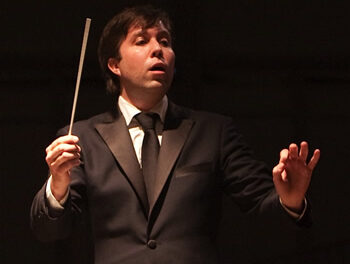It’s a relatively unsung treasure, lurking at NCSU, close enough – as the crow flies – to the diverse splendors represented by the big-ticket folks who hang out in Meymandi Concert Hall. But the Raleigh Civic Chamber Orchestra offers certain splendors of its own, splendors of the artistic persuasion – and splendors, too, in programming, which isn’t driven by marketing considerations. The orchestra’s October 3 concert was given in the far-from-splendid confines of the Student Center’s Ballroom, where the audience – reasonably substantial this time (and especially so, given that the N&O didn’t list the event in its calendars…) – is on the same level as the players, since there is no stage. The program marked anniversaries of two big-name composers with music that may not turn up anywhere else in the Triangle this season. The composers were Dvorák and Ives. The former died 100 years ago this year (on May 1, 1904, to be precise), and the latter, on May 19, 1954. From the former came not one of the big warhorses but rather six excerpts from Legends , Op. 59, originally for piano four-hands, preceded by the Slavonic Dance No. 8, also originally for piano four-hands. Both were given in arrangements (or transcriptions) by the composer. After a short intermission, the RCCO offered Ives’ Symphony No. 3, the smallest but arguably most appealing of his large-scale orchestral works, which coincidentally was written in the year Dvorák passed away (although it probably didn’t contribute to his death…).
It’s always instructive and sometimes immensely satisfying to hear groups that are not fully professional, in part because the younger members are often keenly attentive and – as our old choirmaster used to say – frisky, and also because the older members are there in large measure because they love making music and have not been beaten down by too many years in the trenches. These attributes are evident in the ranks of the RCCO, and the group has another big advantage, too – the players all seem to admire and respect their conductor, Randolph Foy (and, come to think of it, they probably wouldn’t be there if they didn’t). Maestro Foy is a fine conductor and a fine scholar, too, so his program notes and remarks are invariably informed and informative, and that was certainly the case on this occasion, when he linked two superficially disparate composers in numerous ways beyond their obvious artistic kinship.
The opening Slavonic Dance, in g minor, served as an overture of sorts, and a sprightly one it was, too, admirably inflected and played with degrees of incisiveness that would have been unimaginable in NCSU orchestras a few years ago. Foy let no moss grow, coming into the room, jumping onto the low platform, and giving the downbeat before most of us had completely settled. The Legends were marvelous in different ways, since they are far more introspective bits of tone painting mingled with story telling – although (as with Rimsky-Korsakov’s Scheherazade ) we don’t know exactly what the stories are. These turned out to be tours-de-force for the instrumentalists, and the various small sections did quite well, overall. There were some intonation and ensemble problems here and later, too, and some attacks and cutoffs weren’t terribly clean. One would fault a fully professional band for sloppiness in these matters, but here it may be enough to recall that it’s early in the term. (The RCCO isn’t the only area band that we’ll measure with a somewhat flexible yardstick this fall.)
Ives remains a challenge to some, a bit of a joke to others, and a passion for those who’ve invested the time and effort to begin to figure him out. Foy introduced “The Camp Meeting,” which is, typically, loaded up with this and that, in the best possible way – by having his orchestra (or solo artists within it) play “straight” versions of some of the familiar hymn tunes that, with many other fragments, are woven into the piece. Doing it this way means that the themes are fresh in the mind and thus can serve as landmarks as the score unfolds. It helped, too, that the performance was so beautiful and played with such infectious spirit. Some members of the audience looked puzzled, and it may have seemed even stranger when the Symphony was first heard, although it wasn’t all that long ago: it was written in 1904 and revised in 1909 but not premiered till 1946, when composer Lou Harrison conducted it. (It won the Pulitzer in 1947.) There are raspberries among the hymns, some downright peculiar juxtapositions, rampant key changes, and sections that sound wrong but are right – and that were, on this occasion, mostly so. I must say that I’ve heard subtler and even smoother readings of the work, but I’ve never heard a performance that went quite as directly to the core of the matter as this one did. The third movement, in particular, seemed to grow organically before our very ears – it is probably the best part of the Symphony – and when it ended, with off-stage chimes, it was truly ethereal. Ives at NCSU? Wow!











